Perseverance (rover)
Perseverance, nicknamed Percy, is a car-sized Mars rover designed to explore the Jezero crater on Mars as part of NASA's Mars 2020 mission. It was manufactured by the Jet Propulsion Laboratory and was launched on 30 July 2020, at 7:50 a.m. EDT (11:50 UTC),[1] and is scheduled to land on Mars on 18 February 2021, 3 p.m EST/8 p.m UTC.[2]
| Perseverance | |
|---|---|
| Part of Mars 2020 | |
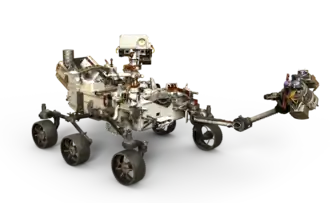 Artist's concept of Perseverance | |
| Other name(s) |
|
| Type | Mars rover |
| Manufacturer | Jet Propulsion Laboratory |
| Technical details | |
| Length | 2 m (6 ft 7 in) |
| Diameter | 2.7 m (8 ft 10 in) |
| Height | 2.2 m (7 ft 3 in) |
| Launch mass | 1,025 kg (2,260 lb) |
| Power | 110 W (0.15 hp) |
| Flight history | |
| Launch date | 30 July 2020, 11:50 UTC [1] |
| Launch site | Cape Canaveral, SLC-41 |
| Landing date | 18 February 2021, 20:00 UTC (planned) [1] |
| Landing site | Jezero crater |
| Instruments | |
NASA Mars rovers | |
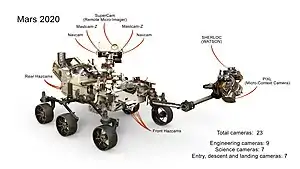
Perseverance carries seven scientific instruments to study the Martian surface at Jezero crater. It carries several cameras and two microphones. The rover is accompanied by the helicopter Ingenuity, which will help Perseverance to scout for locations to study.
Design
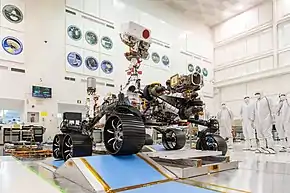
The Perseverance rover was designed with help from the Curiosity's engineering team as they are quite similar to each other.[3][4] Engineers redesigned the Perseverance rover wheels to be more robust than Curiosity's wheels, which have sustained some damage.[5] The rover has thicker, more durable aluminum wheels, with reduced width and a greater diameter (52.5 cm (20.7 in)) than Curiosity's 50 cm (20 in) wheels.[6][7] The aluminum wheels are covered with cleats for traction and curved titanium spokes for springy support.[8] The combination of the larger instrument suite, new Sampling and Caching System, and modified wheels makes Perseverance heavier than its predecessor, Curiosity,[7] by 14% (899 kg to 1025 kg).[9]) The rover will include a five-jointed robotic arm measuring 2.1 m (6 ft 11 in) long. The arm will be used in combination with a turret to analyze geologic samples from the Martian surface.[10]
The rover's power generator (MMRTG) has a mass of 45 kilograms (99 lb) and uses 4.8 kilograms (11 lb) of plutonium dioxide as the source of steady supply of heat that is converted to electricity.[11] The electrical power generated is approximately 110 watts at launch with little decrease over the mission time.[11] Two lithium-ion rechargeable batteries are included to meet peak demands of rover activities when the demand temporarily exceeds the MMRTG's steady electrical output levels. The MMRTG offers a 14-year operational lifetime, and it was provided to NASA by the US Department of Energy.[11] Unlike solar panels, the MMRTG provides engineers with significant flexibility in operating the rover's instruments even at night and during dust storms, and through the winter season.[11]
The rover's computer uses the BAE RAD750 radiation-hardened single board computer. The computer contains 128 megabytes of volatile DRAM, and is run at 133 MHz. The flight software is able to access 4 gigabytes of NAND non-volatile memory on a separate card.[12]
Also travelling with Perseverance as a part of Mars 2020 is the Mars helicopter experiment, named Ingenuity. A solar-powered helicopter drone with a mass of 1.8 kilograms (4.0 lb), it will be tested for flight stability and for its potential to scout the best driving route for the rover over a planned 30-day period.[13] Other than cameras, it carries no scientific instruments.[14][15][16]
Mission
Science objectives
.jpg.webp)
The Perseverance rover has four science objectives that support the Mars Exploration Program's science goals:[17]
- Looking for habitability: identify past environments capable of supporting microbial life.
- Seeking biosignatures: seek signs of possible past microbial life in those habitable environments, particularly in special rocks known to preserve signs over time.
- Caching samples: collect core rock and "soil" samples and store them on the Martian surface.
- Preparing for humans: test oxygen production from the Martian atmosphere.
Name
Associate Administrator of NASA's Science Mission Directorate, Thomas Zurbuchen selected the name Perseverance following a nationwide K-12 student "name the rover" contest that attracted more than 28,000 proposals. A seventh-grade student from Virginia, Alexander Mather from Lake Braddock Secondary School in Burke, Virginia, submitted the winning entry at the Jet Propulsion Laboratory. In addition to the honor of naming the rover, Mather and his family were invited to NASA's Kennedy Space Center to watch the rover's July 2020 launch from Cape Canaveral Air Force Station in Florida.
Mather wrote in his winning essay:
"Curiosity. InSight. Spirit. Opportunity. If you think about it, all of these names of past Mars rovers are qualities we possess as humans. We are always curious, and seek opportunity. We have the spirit and insight to explore the Moon, Mars, and beyond. But, if rovers are to be the qualities of us as a race, we missed the most important thing. Perseverance. We as humans evolved as creatures who could learn to adapt to any situation, no matter how harsh. We are a species of explorers, and we will meet many setbacks on the way to Mars. However, we can persevere. We, not as a nation but as humans, will not give up. The human race will always persevere into the future".[18]
Travel Status
The Perseverance rover lifted off successfully on 30 July 2020, at 11:50 UTC (7:50 a.m. EDT) aboard a United Launch Alliance Atlas V launch vehicle from Space Launch Complex 41 at Cape Canaveral Space Force Station in Florida.[19]
The rover will take about seven months to travel to the Red Planet and will begin its descent on 18 February 2021, after which it will make its landing in Jezero Crater to begin its science phase.[20]


Current location
NASA's Eyes on the Solar System website provides a real-time tracking system for Perseverance and Ingenuity during their six-month interplanetary cruise phase.[21] The interactive site provides controls to customise the viewing experience.
Instruments
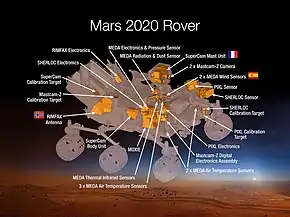
Based on the scientific objectives, nearly 60 proposals [22][23] for rover instrumentation were evaluated and, on 31 July 2014, NASA announced seven scientific instruments that would make up the payload for the rover:[24][25]
- Planetary Instrument for X-Ray Lithochemistry (PIXL), an X-ray fluorescence spectrometer to determine the fine scale elemental composition of Martian surface materials.[26][27]
- Radar Imager for Mars' subsurface experiment (RIMFAX), a ground-penetrating radar to image different ground densities, structural layers, buried rocks, meteorites, and detect underground water ice and salty brine at 10 metres (33 ft) depth. The RIMFAX is being provided by the Norwegian Defence Research Establishment (FFI).[28][29][30]
- Mars Environmental Dynamics Analyzer (MEDA), a set of sensors that measure temperature, wind speed and direction, pressure, relative humidity, radiation, and dust particle size and shape. It will be provided by Spain's Centro de Astrobiología.[31]
- Mars Oxygen ISRU Experiment (MOXIE), an exploration technology investigation that will produce a small amount of oxygen (O
2) from Martian atmospheric carbon dioxide (CO
2).[32] This technology could be scaled up in the future for human life support or to make the rocket fuel for return missions.[32]
- SuperCam, an instrument suite that can provide imaging, chemical composition analysis, and mineralogy in rocks and regolith from a distance. It is an upgraded version of the ChemCam on the Curiosity rover but with two lasers and four spectrometers that will allow it to remotely identify biosignatures and assess the past habitability. Los Alamos National Laboratory, the Research Institute in Astrophysics and Planetology (IRAP) in France, the French Space Agency (CNES), the University of Hawaii, and the University of Valladolid in Spain cooperated in the SuperCam's development and manufacture.[33]
- Mastcam-Z, a stereoscopic imaging system with the ability to zoom.
- Scanning Habitable Environments with Raman and Luminescence for Organics and Chemicals (SHERLOC), an ultraviolet Raman spectrometer that uses fine-scale imaging and an ultraviolet (UV) laser to determine fine-scale mineralogy and detect organic compounds.[34][35]
There are also a number of cameras, and for the first time on a Mars probe, two audio microphones will be used during the landing event,[36] while driving, and when collecting samples.[37]
"Send Your Name to Mars"
NASA's "Send Your Name to Mars" campaign invited people around the world to submit their names to ride aboard the agency's next rover to the Red Planet. Around 10,932,295 people submitted their names. The names were stenciled by electron beam onto three fingernail-sized silicon chips, along with the essays of the 155 finalists in NASA's "Name the Rover" contest. The chips were then attached to an aluminium plate. The three chips share space on the anodized plate with a laser-etched graphic depicting Earth, Mars and the Sun. The plate was then mounted onto the rover on 26 March 2020.[38]
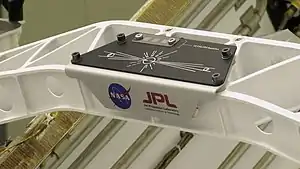

Tribute to healthcare workers plate
Perseverance launched during the COVID-19 pandemic which began to affect the mission planning in March 2020. To show appreciation for healthcare workers who helped during the pandemic, an 8 cm × 13 cm (3.1 in × 5.1 in) plate with a staff-and serpent symbol was placed on the rover. The project manager, Matt Wallace, said he hoped that future generations going to Mars would be able to appreciate healthcare workers during 2020.[39]
See also
References
- "Launch Windows". mars.nasa.gov. NASA. Retrieved 28 July 2020.
 This article incorporates text from this source, which is in the public domain.
This article incorporates text from this source, which is in the public domain. - Taylor, Alan (29 July 2020). "Photos: NASA Prepares to Launch the Mars Rover Perseverance". The Atlantic. Retrieved 30 July 2020.
- Harwood, William (4 December 2012). "NASA announces plans for new US$1.5 billion Mars rover". CNET. Retrieved 5 December 2012.
Using spare parts and mission plans developed for NASA's Curiosity Mars rover, the space agency says it can launch the rover in 2020 and stay within current budget guidelines.
- Wall, Mike (4 December 2012). "NASA to Launch New Mars Rover in 2020". Space.com. Retrieved 5 December 2012.
- Lakdawalla, Emily (19 August 2014). "Curiosity wheel damage: The problem and solutions". planetary.org. The Planetary Society. Retrieved 22 August 2014.
- Gebhardt, Chris. "Mars 2020 rover receives upgraded eyesight for tricky skycrane landing". NASASpaceFlight. Retrieved 11 October 2016.
- "Mars 2020 – Body: New Wheels for Mars 2020". NASA/JPL. Retrieved 6 July 2018.
 This article incorporates text from this source, which is in the public domain.
This article incorporates text from this source, which is in the public domain. - "Mars 2020 Rover – Wheels". NASA. Retrieved 9 July 2018.
 This article incorporates text from this source, which is in the public domain.
This article incorporates text from this source, which is in the public domain. - "NASAfacts: Mars 2020/Perseverance" (PDF). 26 July 2020. Archived from the original (PDF) on 26 July 2020. Retrieved 13 August 2020.
 This article incorporates text from this source, which is in the public domain.
This article incorporates text from this source, which is in the public domain. - "Mars 2020 Rover's 7-Foot-Long Robotic Arm Installed". mars.nasa.gov. 28 June 2019. Retrieved 1 July 2019.
The main arm includes five electrical motors and five joints (known as the shoulder azimuth joint, shoulder elevation joint, elbow joint, wrist joint and turret joint). Measuring 7 feet (2.1 meters) long, the arm will allow the rover to work as a human geologist would: by holding and using science tools with its turret, which is essentially its "hand".
 This article incorporates text from this source, which is in the public domain.
This article incorporates text from this source, which is in the public domain. - "Mars 2020 Rover Tech Specs". JPL/NASA. Retrieved 6 July 2018.
 This article incorporates text from this source, which is in the public domain.
This article incorporates text from this source, which is in the public domain. - "Prototyping an Onboard Scheduler for the Mars 2020 Rover" (PDF). NASA.
 This article incorporates text from this source, which is in the public domain.
This article incorporates text from this source, which is in the public domain. - "Mars Helicopter to Fly on NASA's Next Red Planet Rover Mission". NASA. Retrieved 11 May 2018.
 This article incorporates text from this source, which is in the public domain.
This article incorporates text from this source, which is in the public domain. - "Mars mission readies tiny chopper for Red Planet flight". bbc.com. BBC News. 29 August 2019.
- Chang, Kenneth. "A Helicopter on Mars? NASA Wants to Try". The New York Times. Retrieved 12 May 2018.
- Gush, Loren (11 May 2018). "NASA is sending a helicopter to Mars to get a bird's-eye view of the planet – The Mars Helicopter is happening, y'all". The Verge. Retrieved 11 May 2018.
- "Overview". mars.nasa.gov. NASA. Retrieved 6 October 2020.
 This article incorporates text from this source, which is in the public domain.
This article incorporates text from this source, which is in the public domain. - "Name the Rover". mars.nasa.gov. NASA. Retrieved 20 October 2020.
 This article incorporates text from this source, which is in the public domain.
This article incorporates text from this source, which is in the public domain. - Drake, Nadia. "NASA's newest Mars rover begins its journey to hunt for alien life". nationalgeographic.com. National Geographic. Retrieved 30 July 2020.
- "Mission Timeline > Cruise". mars.nasa.gov. NASA.
- "Follow NASA's Perseverance Rover in Real Time on Its Way to Mars". mars.nasa.gov. NASA. Retrieved 20 October 2020.
- Webster, Guy; Brown, Dwayne (21 January 2014). "NASA Receives Mars 2020 Rover Instrument Proposals for Evaluation". NASA. Retrieved 21 January 2014.
 This article incorporates text from this source, which is in the public domain.
This article incorporates text from this source, which is in the public domain. - Timmer, John (31 July 2014). "NASA announces the instruments for the next Mars rover". ARS Technica. Retrieved 7 March 2015.
- Brown, Dwayne (31 July 2014). "Release 14-208 – NASA Announces Mars 2020 Rover Payload to Explore the Red Planet as Never Before". NASA. Retrieved 31 July 2014.
 This article incorporates text from this source, which is in the public domain.
This article incorporates text from this source, which is in the public domain. - Brown, Dwayne (31 July 2014). "NASA Announces Mars 2020 Rover Payload to Explore the Red Planet as Never Before". NASA. Retrieved 31 July 2014.
 This article incorporates text from this source, which is in the public domain.
This article incorporates text from this source, which is in the public domain. - Webster, Guy (31 July 2014). "Mars 2020 Rover's PIXL to Focus X-Rays on Tiny Targets". NASA. Retrieved 31 July 2014.
 This article incorporates text from this source, which is in the public domain.
This article incorporates text from this source, which is in the public domain. - "Adaptive sampling for rover x-ray lithochemistry" (PDF). Archived from the original (PDF) on 8 August 2014.
- "RIMFAX, The Radar Imager for Mars' Subsurface Experiment". NASA. July 2016. Retrieved 19 July 2016.
 This article incorporates text from this source, which is in the public domain.
This article incorporates text from this source, which is in the public domain. - Chung, Emily (19 August 2014). "Mars 2020 rover's RIMFAX radar will 'see' deep underground". cbc.ca. Canadian Broadcasting Corp. Retrieved 19 August 2014.
- U of T scientist to play key role on Mars 2020 Rover Mission
- In-Situ Resource Utilization (ISRU) Archived April 2, 2015, at the Wayback Machine
 This article incorporates text from this source, which is in the public domain.
This article incorporates text from this source, which is in the public domain. - Jet Propulsion Laboratory (JPL). "Mars Oxygen In-Situ Resource Utilization Experiment (MOXIE)". techport.nasa,gov. NASA. Retrieved 28 December 2019.
 This article incorporates text from this source, which is in the public domain.
This article incorporates text from this source, which is in the public domain. - "NASA Administrator Signs Agreements to Advance Agency's Journey to Mars". NASA. 16 June 2015.
 This article incorporates text from this source, which is in the public domain.
This article incorporates text from this source, which is in the public domain. - Webster, Guy (31 July 2014). "SHERLOC to Micro-Map Mars Minerals and Carbon Rings". NASA. Retrieved 31 July 2014.
 This article incorporates text from this source, which is in the public domain.
This article incorporates text from this source, which is in the public domain. - "SHERLOC: Scanning Habitable Environments with Raman and Luminescence for Organics and Chemicals, an Investigation for 2020" (PDF).
- "Microphones on Mars 2020". NASA. Retrieved 3 December 2019.
 This article incorporates text from this source, which is in the public domain.
This article incorporates text from this source, which is in the public domain. - Strickland, Ashley (15 July 2016). "New Mars 2020 rover will be able to "hear" the Red Planet". cnn.com. CNN News.
- "10.9 Million Names Now Aboard NASA's Perseverance Mars Rover". Mars Exploration Program. NASA. 26 March 2020.
 This article incorporates text from this source, which is in the public domain.
This article incorporates text from this source, which is in the public domain. - Wall, Mike (17 June 2020). "NASA's next Mars rover carries tribute to healthcare workers fighting coronavirus". space.com. Space.com. Retrieved 31 July 2020.
External links
| Wikimedia Commons has media related to Perseverance rover. |

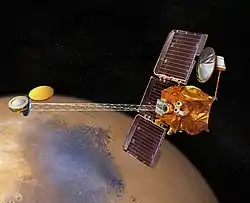
.jpg.webp)
.jpg.webp)


_on_Jul_14_2020_aligned_to_stars.jpg.webp)